Composition and Conservation Value of Epiphytic Lichen Communities on Common Ash in North-Western Alps: A First Assessment
Abstract
:1. Introduction
2. Materials and Methods
2.1. Survey Area and Sampling
2.2. Environmental Variables
2.3. Lichen Survey
2.4. Overview on Lichen Traits
2.5. Data Analysis
3. Results
4. Discussion
5. Conclusions
Supplementary Materials
Author Contributions
Funding
Institutional Review Board Statement
Informed Consent Statement
Data Availability Statement
Conflicts of Interest
References
- FRAXIGEN. Ash Species in Europe: Biological Characteristics and Practical Guidelines for Sustainable Use; Oxford Forestry Institute, University of Oxford: Oxford, UK, 2005; ISBN 9780850741637. [Google Scholar]
- Camerano, P.; Terzuolo, P.G.; Varese, P. I Tipi Forestali Della Valle d’Aosta; Compagnia delle Foreste: Arezzo, Italy, 2000. [Google Scholar]
- Iverson, L.R.; Prasad, A.M. Potential changes in tree species richness and forest community types following climate change. Ecosystems 2001, 4, 186–199. [Google Scholar] [CrossRef]
- Gauslaa, Y.; Palmqvist, K.; Solhaug, K.A.; Holien, H.; Hilmo, O.; Nybakken, L.; Myhre, L.C.; Ohlson, M. Growth of epiphytic old forest lichens across climatic and successional gradients. Can. J. For. Res. 2007, 37, 1832–1845. [Google Scholar] [CrossRef]
- Rodenhouse, N.L.; Christenson, L.M.; Parry, D.; Green, L.E. Climate change effects on native fauna of northeastern forests. Can. J. For. Res. 2009, 39, 249–263. [Google Scholar] [CrossRef]
- Oita, S.; Ibáñez, A.; Lutzoni, F.; Miadlikowska, J.; Geml, J.; Lewis, L.A.; Hom, E.F.Y.; Carbone, I.; U’Ren, J.M.; Arnold, A.E. Climate and seasonality drive the richness and composition of tropical fungal endophytes at a landscape scale. Commun. Biol. 2021, 4, 313. [Google Scholar] [CrossRef] [PubMed]
- Wieczynski, D.J.; Boyle, B.; Buzzard, V.; Duran, S.M.; Henderson, A.N.; Hulshof, C.M.; Kerkhoff, A.J.; McCarthy, M.C.; Michaletz, S.T.; Swenson, N.G.; et al. Climate shapes and shifts functional biodiversity in forests worldwide. Proc. Natl. Acad. Sci. USA 2019, 116, 587–592. [Google Scholar] [CrossRef]
- Miller, J.E.; Villella, J.; Stone, D.; Hardman, A. Using lichen communities as indicators of forest stand age and conservation value. For. Ecol. Manag. 2020, 475, 118436. [Google Scholar] [CrossRef]
- Moe, B.; Botnen, A.A. Quantitative Study of the Epiphytic Vegetation on Pollarded Trunks of Fraxinus Excelsior at Havrå, Osterøy, Western Norway. Plant Ecol. 1997, 129, 157–177. [Google Scholar] [CrossRef]
- Ellis, C.J.; Coppins, B.J.; Eaton, S.; Simkin, J. Implications of Ash Dieback for Associated Epiphytes. Conserv. Biol. 2013, 27, 899–901. [Google Scholar] [CrossRef]
- Nimis, P.L.; Scheidegger, C.; Wolseley, P.A. Monitoring with LichensMonitoring Lichens. Monitoring with Lichens—Monitoring Lichens. In NATO Science Series; Nimis, P.L., Scheidegger, C., Wolseley, P.A., Eds.; Springer: Dordrecht, NL, USA, 2002; Volume 7. [Google Scholar] [CrossRef]
- Ellis, C.J.; Asplund, J.; Benesperi, R.; Branquinho, C.; Di Nuzzo, L.; Hurtado, P.; Martínez, I.; Matos, P.; Nascimbene, J.; Pinho, P.; et al. Functional Traits in Lichen Ecology: A Review of Challenge and Opportunity. Microorganisms 2021, 9, 766. [Google Scholar] [CrossRef]
- Abas, A. A Systematic Review on Biomonitoring Using Lichen as the Biological Indicator: A Decade of Practices, Progress and Challenges. Ecol. Indic. 2021, 121, 107–197. [Google Scholar] [CrossRef]
- Stofer, S.; Catalayud, V.; Ferretti, M.; Fischer, R.; Giordani, P.; Keller, C.; Stapper, N.; Scheidegger, C. Epiphytic Lichen Monitoring within the EU/ICP Forests Biodiversity Test-Phase on Level II Plots. ForestBIOTA (Forest Biodiversity Test-Phase Assessments). 2003. Available online: www.forestbiota.org (accessed on 26 May 2022).
- Giordani, P.; Brunialti, G.; Nascimbene, J.; Gottardini, E.; Cristofolini, F.; Isocrono, D.; Matteucci, E.; Paoli, L. Aspects of biological diversity in the CONECOFOR plots. III. Epiphytic lichens. Ann. Ist. Sper. Selv. 2006, 30, 43–50. [Google Scholar]
- Edwards, B. A Preliminary Assessment of the Importance of Ash Trees for Epiphytic Lichens in the British Isles, Version 1.0. Report of British Lichen Society; British Lichen Society: London, UK, 2012. [Google Scholar]
- Lõhmus, A.; Runnel, K. Ash Dieback Can Rapidly Eradicate Isolated Epiphyte Populations in Production Forests: A Case Study. Biol. Conserv. 2014, 169, 185–188. [Google Scholar] [CrossRef]
- Łubek, A.; Kukwa, M.; Czortek, P.; Jaroszewicz, B. Impact of Fraxinus Excelsior Dieback on Biota of Ash-Associated Lichen Epiphytes at the Landscape and Community Level. Biodivers. Conserv. 2020, 29, 431–450. [Google Scholar] [CrossRef]
- QGIS Development Team. QGIS Geographic Information System; Open Source Geospatial Foundation Project. 2022. Available online: http://www.qgis.org (accessed on 26 May 2022).
- Nimis, P.L. ITALIC—The Information System on Italian Lichens. Version 5.0; University of Trieste, Dept. of Biology: Trieste, Italy, 2016; Available online: https://italic.units.it/ (accessed on 5 May 2022).
- Nascimbene, J.; Nimis, P.L.; Ravera, S. Evaluating the Conservation Status of Epiphytic Lichens of Italy: A Red List. Plant Biosyst. 2013, 147, 898–904. [Google Scholar] [CrossRef]
- Piervittori, R.; Isocrono, D. I Licheni Della Valle d’Aosta—1: Indagine Bibliografica e Aspetti Storici (1764–1998). Monografie 1; Museo Regionale di Scienze Naturali: St. Pierre, Italy, 1999. [Google Scholar]
- Lione, G.; Giordano, L.; Sillo, F.; Gonthier, P. Testing and modelling the effects of climate on the incidence of the emergent nut rot agent of chestnut Gnomoniopsis castanea. Plant Pathol. J. 2015, 64, 852–863. [Google Scholar] [CrossRef]
- Crawley, M.J. The R Book, 2nd ed.; John Wiley & Sons: Chichester, UK, 2013; ISBN 9780470510247. [Google Scholar]
- Kaiser, H.F. The application of electronic computers to factor analysis. Educ. Psychol. Meas. 1960, 20, 141–151. [Google Scholar] [CrossRef]
- Field, A. Discovering Statistics Using SPSS, 3rd ed.; Sage Publication Ltd.: London, UK, 2009. [Google Scholar] [CrossRef]
- Ward, J.H., Jr. Hierarchical grouping to optimize an objective function. J. Am. Stat. Assoc. 1963, 58, 236–244. [Google Scholar] [CrossRef]
- Murtagh, F.; Legendre, P. Ward’s hierarchical agglomerative clustering method: Which algorithms implement Ward’s criterion? J. Classif. 2014, 31, 274–295. [Google Scholar] [CrossRef]
- Gao, C.H.; Yu, G.; Cai, P. ggVennDiagram: An intuitive, easy-to-use, and highly customizable R package to generate Venn diagram. Front. Genet. 2021, 12, 1598. [Google Scholar] [CrossRef]
- Blaker, H. Confidence curves and improved exact confidence intervals for discrete distributions. Can. J. Stat. 2000, 28, 783–798. [Google Scholar] [CrossRef]
- Agresti, A. Categorical Data Analysis; John Wiley & Sons: Hoboken, NJ, USA, 2003. [Google Scholar] [CrossRef]
- Benjamini, Y.; Hochberg, Y. Controlling the false discovery rate: A practical and powerful approach to multiple testing. J. R. Stat. Soc. Ser. B Stat. Methodol. 1995, 57, 289–300. [Google Scholar] [CrossRef]
- Hope, A.C. A simplified Monte Carlo significance test procedure. J. R. Stat. Soc. Ser. B Stat. Methodol. 1968, 30, 582–598. [Google Scholar] [CrossRef]
- R Core Team. R: A Language and Environment for Statistical Computing; R Foundation for Statistical Computing: Vienna, Austria, 2019; Available online: https://www.R-project.org/ (accessed on 27 October 2019).
- Chmura, D.; Żarnowiec, J.; Staniaszek-Kik, M. Altitude Is a Better Predictor of the Habitat Requirements of Epixylic Bryophytes and Lichens than the Presence of Coarse Woody Debris in Mountain Forests: A Study in Poland. Ann. For. Sci. 2022, 79, 7. [Google Scholar] [CrossRef]
- Farmer, A.M.; Bates, J.W.; Bell, J.N.B. Comparisons of Three Woodland Sites in NW Britain Differing in Richness of the Epiphytic Lobarion Pulmonariae Community and Levels of Wet Acidic Deposition. Ecography 1991, 14, 85–91. [Google Scholar] [CrossRef]
- Paltto, H.; Thomasson, I.; Nordén, B. Multispecies and Multiscale Conservation Planning: Setting Quantitative Targets for Red-Listed Lichens on Ancient Oaks. Conserv. Biol. 2010, 24, 758–768. [Google Scholar] [CrossRef]
- Aptroot, A.; van Herk, C.M. Further evidence of the effects of global warming on lichens, particularly those with Trentepohlia phycobionts. Environ. Pollut. 2007, 146, 293–298. [Google Scholar] [CrossRef]
- Thor, G.; Johansson, P.; Jönsson, M.T. Lichen Diversity and Red-Listed Lichen Species Relationships with Tree Species and Diameter in Wooded Meadows. Biodivers. Conserv. 2010, 19, 2307–2328. [Google Scholar] [CrossRef]
- Nimis, P.L.; Hafellner, J.; Roux, C.; Clerc, P.; Mayrhofer, H.; Martellos, S.; Bilovitz, P.O. The lichens of the Alps—An annotated checklist. MycoKeys 2018, 31, 1–634. [Google Scholar] [CrossRef]
- Næsborg, R.R.; Ekman, S.; Tibell, L. Molecular phylogeny of the genus Lecania (Ramalinaceae, lichenized Ascomycota). Mycol. Res. 2007, 111, 581–591. [Google Scholar] [CrossRef]
- Næsborg, R.R. Taxonomic revision of the Lecania cyrtella group based on molecular and morphological evidence. Mycologia 2008, 100, 397–416. [Google Scholar] [CrossRef]
- Jüriado, I.; Liira, J.; Paal, J.; Suija, A. Tree and Stand Level Variables Influencing Diversity of Lichens on Temperate Broad-Leaved Trees in Boreo-Nemoral Floodplain Forests. Biodivers. Conserv. 2008, 18, 105. [Google Scholar] [CrossRef]
- Ravera, S.; Bianchi, E.; Brunialti, G.; Ciotti, R.; Di Nuzzo, L.; Isocrono, D.; Gheza, G.; Giordani, P.; Guttová, A.; Malíček, J.; et al. Studia Lichenologica in Italy. I. New records of red-listed species. Borziana 2021, 2, 87–108. [Google Scholar] [CrossRef]
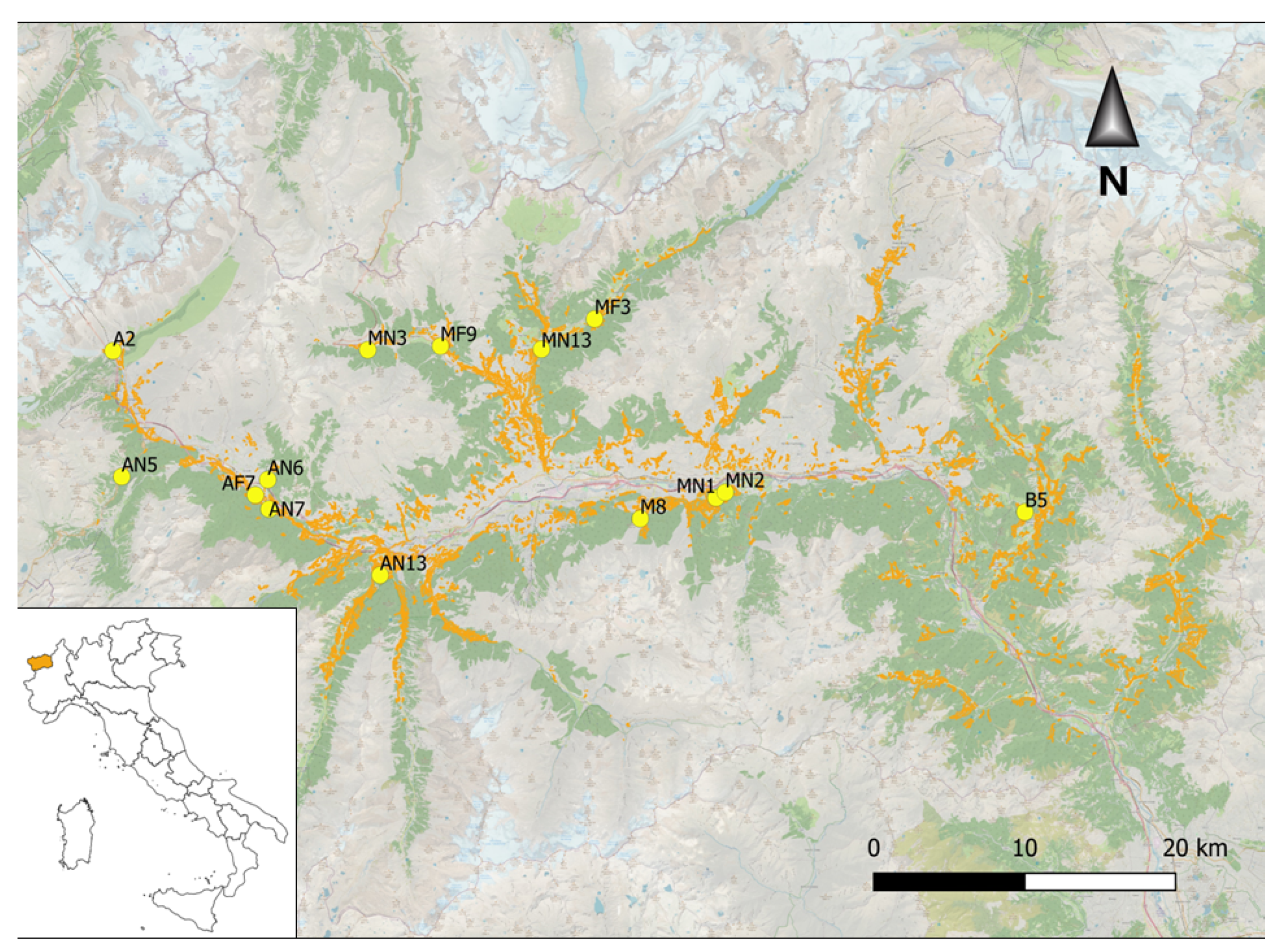
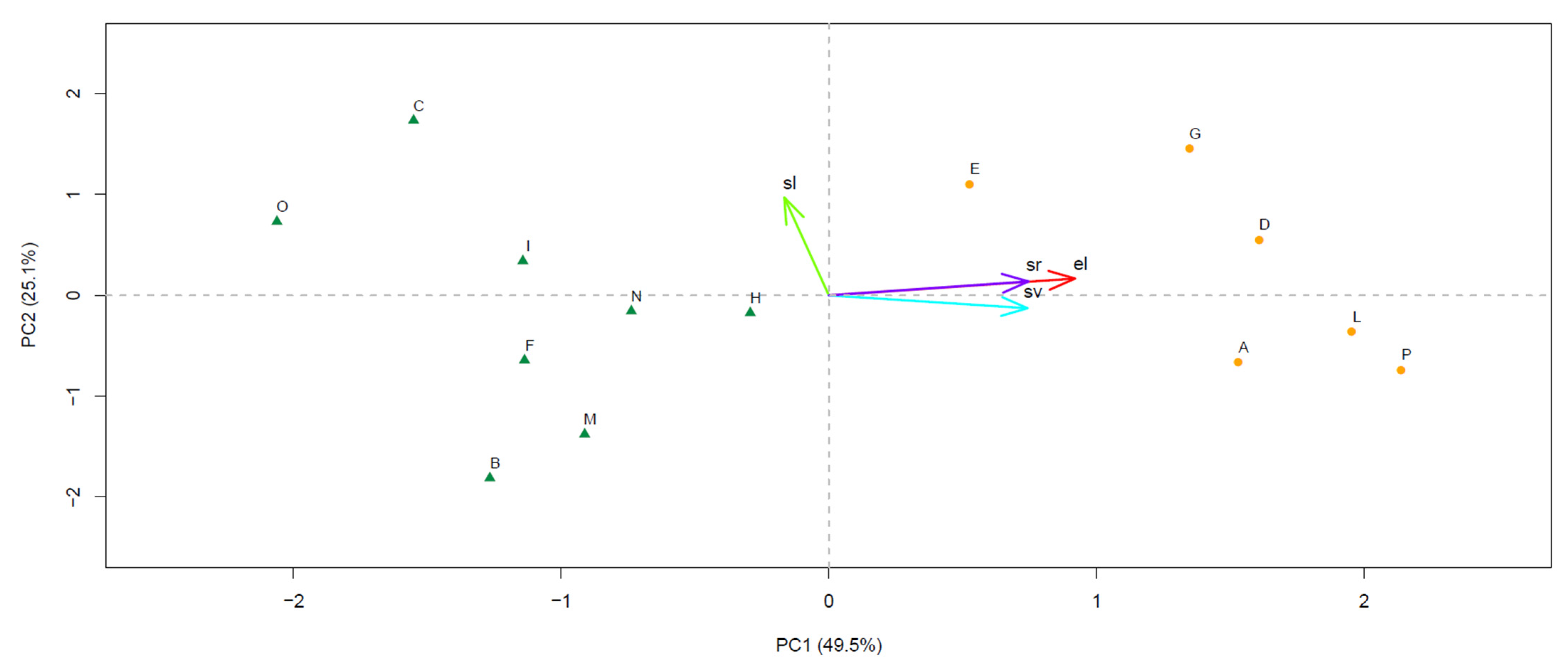
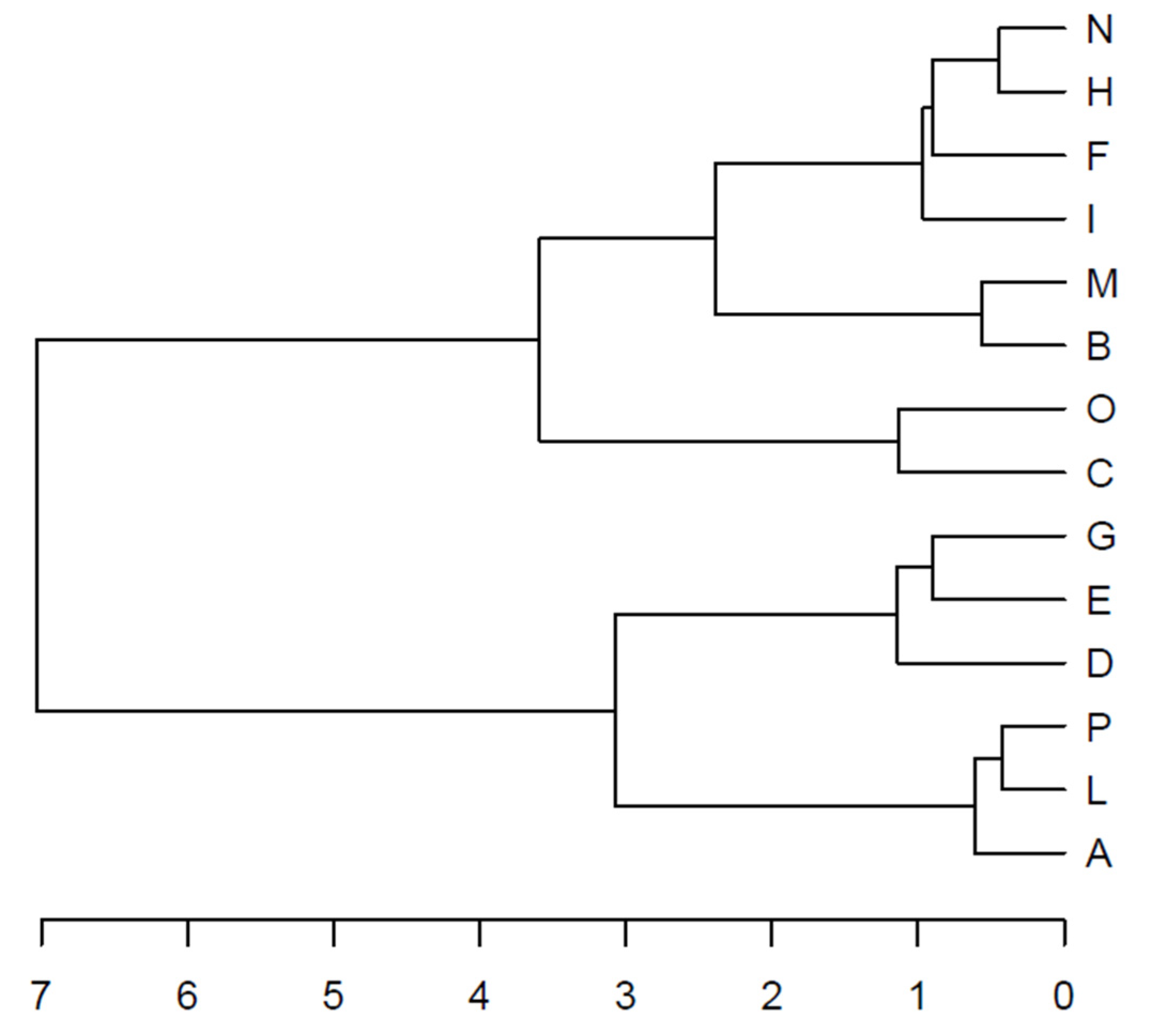
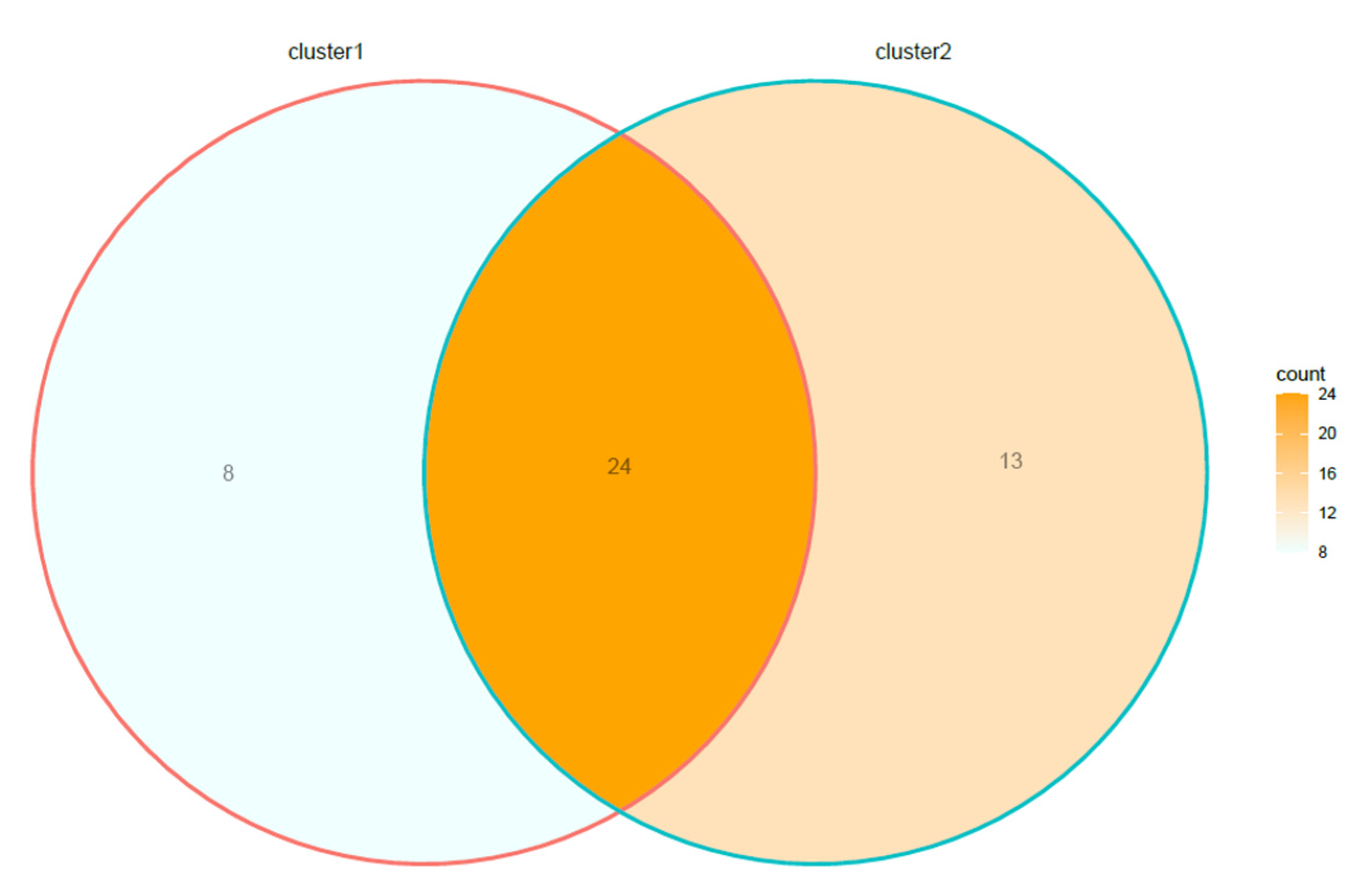
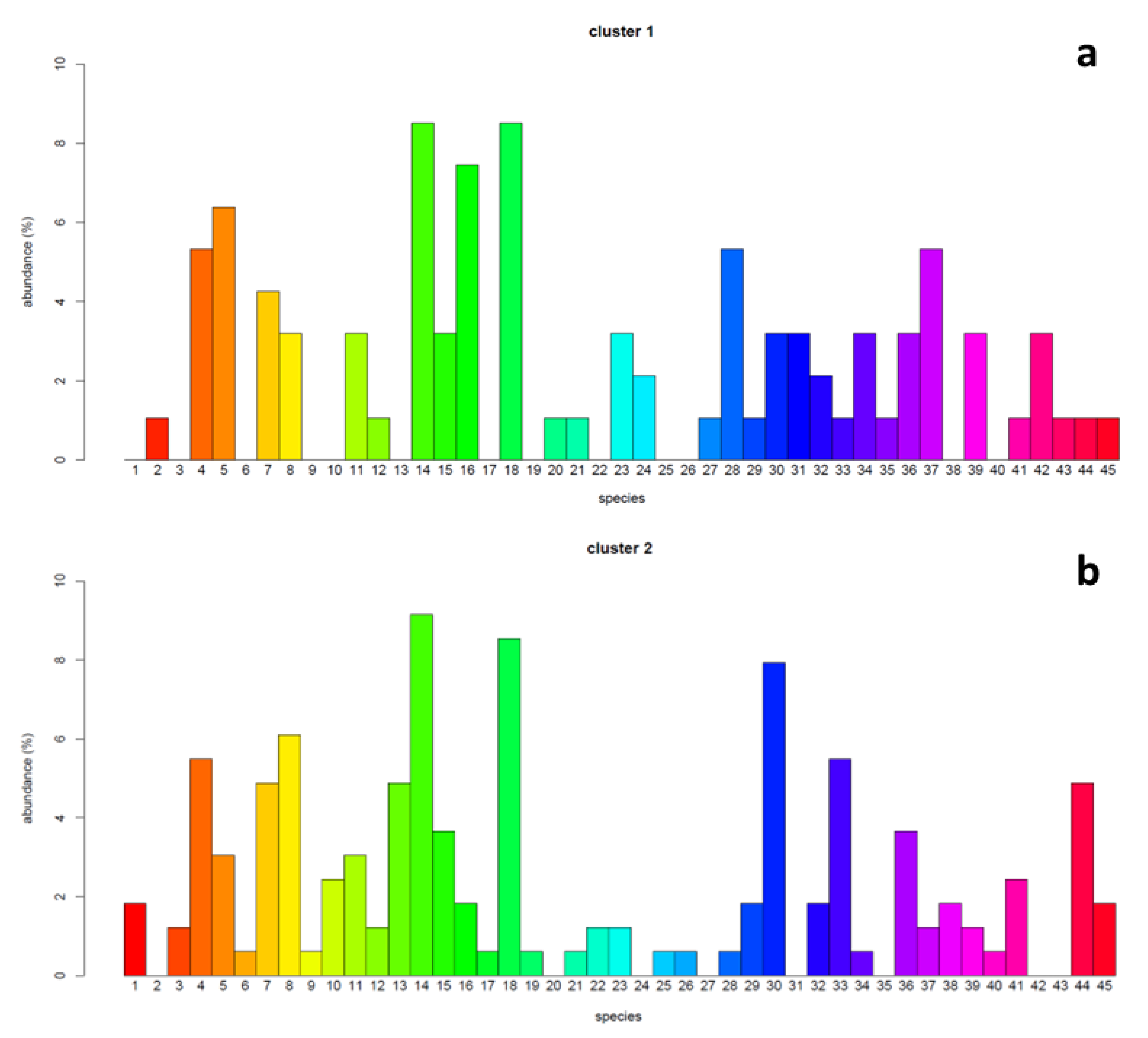
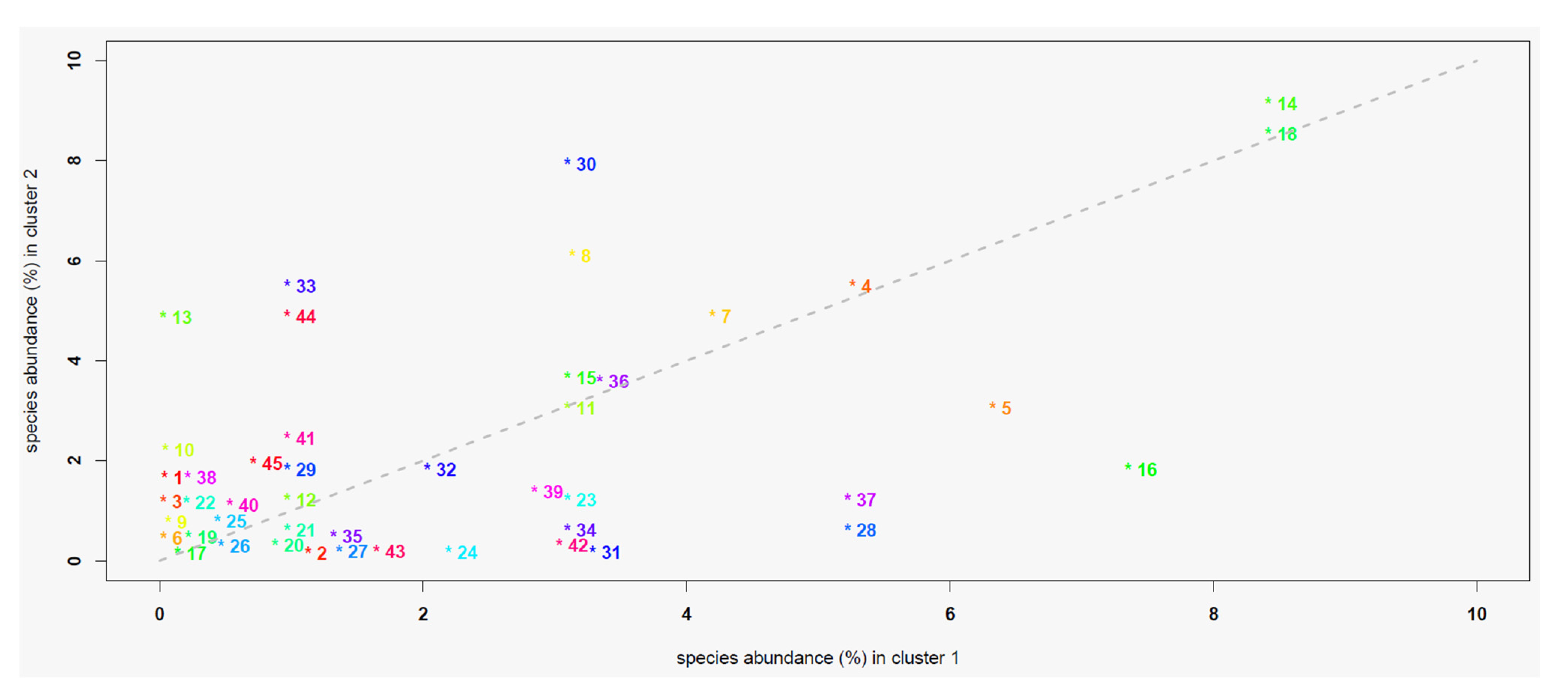
| Feature | Description |
|---|---|
| Light EIV | Ordinary scale from 1 (in very shaded situations) to 5 (in sites with very high direct solar irradiation) |
| Growth form | Cr—crustose, FoN—foliose narrow-lobed, FoB—foliose broad-lobed |
| Photobiont | S—sexual, So—soredia, I—isidia |
| Species | Code | Status | Rarity |
|---|---|---|---|
| Arthonia radiata (Pers.) Ach. | 1 | § | rather common |
| Arthonia ruana A. Massal. | 2 | ^ | very rare |
| Arthopyrenia cerasi (Schrad.) A. Massal. | 3 | ^ | - |
| Athallia cerinelloides (Erichsen) Arup, Frödén & Søchting | 4 | ^ | rare |
| Caloplaca cerina (Hedw.) Th. Fr. | 5 | rather rare | |
| Candelaria concolor (Dicks.) Stein | 6 | very rare | |
| Candelariella xanthostigma (Ach.) Lettau | 7 | rather common | |
| Catillaria nigroclavata (Nyl.) J. Steiner | 8 | rather rare | |
| Collema flaccidum (Ach.) Ach. | 9 | very rare | |
| Hyperphyscia adglutinata (Kremp.) A. Massal. | 10 | very rare | |
| Lecania cyrtella (Ach.) Th. Fr. | 11 | rather rare | |
| Lecania cyrtellina (Nyl.) Sandst. | 12 | ^ | rare |
| Lecania naegelii (Hepp) Diederich & van den Boom | 13 | ^ | very rare |
| Lecanora chlarothera Nyl. subsp. chlarotera | 14 | common | |
| Lecanora impudens Degel. | 15 | ^, * | extremely rare |
| Lecanora leptyrodes (Nyl.) Degel. | 16 | extremely common | |
| Lecanora populicola (DC.) Duby | 17 | ^ | very rare |
| Lecidella elaeochroma (Ach.) M. Choisy var. elaeochroma f. elaeochroma | 18 | rather common | |
| Lepraria finkii (B. de Lesd.) R.C. Harris | 19 | ^ | rather common |
| Leptogium saturninum (Dicks.) Nyl. | 20 | rare | |
| Melanelixia glabratula (Lamy) Sandler & Arup | 21 | extremely common | |
| Melanelixia glabra (Schaer.) O. Blanco, A. Crespo, Divakar, Essl., D. Hawksw. & Lumbsch | 22 | rather rare | |
| Myriolecis hagenii (Ach.) Śliwa, Zhao Xin & Lumbsch | 23 | rather rare | |
| Parmelia sulcata Taylor | 24 | extremely common | |
| Parmelina quercina (Willd.) Hale | 25 | rare | |
| Parmelina tiliacea (Hoffm.) Hale | 26 | rather common | |
| Phaeophyscia ciliata (Hoffm.) Moberg | 27 | § | rather rare |
| Phaeophyscia hispidula (Ach.) Essl. | 28 | ^ | extremely rare |
| Phaeophyscia nigricans (Flörke) Moberg | 29 | extremely rare | |
| Phaeophyscia orbicularis (Neck.) Moberg | 30 | rare | |
| Phaeophyscia poeltii (Frey) Nimis | 31 | - | |
| Phaeophyscia pusilloides (Zahlbr.) Essl. | 32 | ^ | extremely rare |
| Physcia adscendens H. Olivier | 33 | rather common | |
| Physcia aipolia (Humb.) Fürnr. | 34 | rather rare | |
| Physcia biziana (A. Massal.) Zahlbr. var. biziana | 35 | - | |
| Physcia stellaris (L.) Nyl. | 36 | very common | |
| Physconia distorta (With.) J.R. Laundon | 37 | rather rare | |
| Pseudoschismatomma rufescens (Pers.) Ertz & Tehler | 38 | ^ | rather rare |
| Rinodina ficta (Stizenb.) Zahlbr. | 39 | ^ | - |
| Rinodina polyspora Th. Fr. | 40 | * | extremely rare |
| Rinodina pyrina (Ach.) Arnold | 41 | rather rare | |
| Xanthomendoza fallax (Hepp) Søchting, Kärnefelt & S.Y. Kondr. | 42 | rather rare | |
| Xanthomendoza fulva (Hoffm.) Søchting, Kärnefelt & S.Y. Kondr. | 43 | ^ | very rare |
| Xanthoria parietina (L.) Th. Fr. | 44 | rather common | |
| Xanthomendoza ulophyllodes (Räsänen) Søchting, Kärnefelt & S.Y. Kondr. | 45 | ^ | very rare |
| Cluster | Classes | f |
|---|---|---|
| 1 | 2–3 | 0.125 |
| 3–5 | 0.125 | |
| 4 | 0.125 | |
| 4–5 | 0.625 | |
| 2 | 2–3 | 0.083 |
| 2–4 | 0.083 | |
| 3–4 | 0.417 | |
| 4 | 0.083 | |
| 4–5 | 0.333 |
Publisher’s Note: MDPI stays neutral with regard to jurisdictional claims in published maps and institutional affiliations. |
© 2022 by the authors. Licensee MDPI, Basel, Switzerland. This article is an open access article distributed under the terms and conditions of the Creative Commons Attribution (CC BY) license (https://creativecommons.org/licenses/by/4.0/).
Share and Cite
Ongaro, S.; Lione, G.; Isocrono, D. Composition and Conservation Value of Epiphytic Lichen Communities on Common Ash in North-Western Alps: A First Assessment. Forests 2022, 13, 1288. https://doi.org/10.3390/f13081288
Ongaro S, Lione G, Isocrono D. Composition and Conservation Value of Epiphytic Lichen Communities on Common Ash in North-Western Alps: A First Assessment. Forests. 2022; 13(8):1288. https://doi.org/10.3390/f13081288
Chicago/Turabian StyleOngaro, Silvia, Guglielmo Lione, and Deborah Isocrono. 2022. "Composition and Conservation Value of Epiphytic Lichen Communities on Common Ash in North-Western Alps: A First Assessment" Forests 13, no. 8: 1288. https://doi.org/10.3390/f13081288
APA StyleOngaro, S., Lione, G., & Isocrono, D. (2022). Composition and Conservation Value of Epiphytic Lichen Communities on Common Ash in North-Western Alps: A First Assessment. Forests, 13(8), 1288. https://doi.org/10.3390/f13081288







